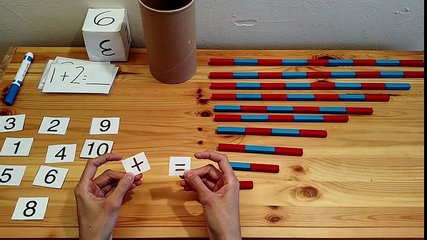Montessori Makes Math Easy and Fun
When we think of the way that most of us learned addition -the most basic concept of mathematics- we think of the classic: 2+2=4 method. Most people believe that small children need to start with small addition. And honestly, some of our first experiences with addition probably involved a chalkboard or worksheet, which is why math is not a very popular subject (regarding ease of understand ability). Safe to say the traditional approach of teaching mathematics revolves around the concept of remembering it long enough to repeat it onto a test, and that’s pretty much the gist of it.
So, does that mean there is no solution? Are we likely to follow the same teaching technique? Like most of the situations, there is a solution available in this case. And that admittedly falls in the Montessori Method of education.
Math made easy!
Mathematics in Montessori is all about traversing with the senses. The method is all about engaging children and empowering them to learn through exploration with their hands, manipulating materials, and utilising their senses to take in information. Maria Montessori had believed that math could be taught to children in the same way. Math is a collection of the abstract concepts, but if these abstract concepts can be personified in a physical shape which can be manipulated, then children can learn those concepts at a much younger age and have them stick with them for a long time.
Thus it is important to mention the concept of addition by adding big, four category numbers, rather than the typical 2+2. So, what’s this concept? In a nutshell, this concept revolves around the use of the Golden Beads (aka Montessori math beads.) These Montessori Math Beads help children comprehend the decimal system and understand the categories of a unit, ten, hundred, and thousand.
What exactly is a Montessori Math Bead?
These materials were created for Elementary age children, but Dr Montessori saw that the younger children were fascinated by them. Originally she thought that 3-6-year-olds were too young to grasp these concepts of large numbers, but the children showed her they were ready for it. The way the Golden Beads are constructed is what allows the young child to be able to work with them. Because the large quantities are bound together, the child can comfortably count the large numbers.
If units can be counted up to 9, then so can tens, hundreds, and thousands, as long as they are bound together. Once a child has an understanding of the categories, we introduce the child to the concept of addition, using four category numbers. We may ask one child to bring 1,345 and another to bring 2,764, and another to bring 3,712. Then we put all those quantities together on a big tray, and count how much it made, telling the children, “This is called addition!”
When children are adding four category numbers, the sum is quite large and therefore makes a bigger impression. They not only work together to add the beads and figure out the answer but can experience with their senses what addition means. They can see on the tray that when they put their smaller numbers together, it made a BIG number. They can feel how heavy the tray is as well, making another sensorial impression. Later on, when children are engaged in any other addition work, their attempt is reviewed in the presence of a child. And if asked about what addition means, and they may say something like “That’s when we put numbers together to make a big number!”
Experts at Milton Montessori remark that after a child has experienced the four operations, they begin to use paper and pencil along with the math materials to work on memorising their essential math facts such as 2+2=4, for instance. Because they had that sensorial proficiency with addition through working with the Montessori Beads, they now have a thorough understanding of what addition means, and there is more relevance to 2+2=4.
Math Can Be Fun!
To many of us adults, math is seen as a chore, but if understood properly, the child will start to see math in an entirely different light. They will not dread it or find it hard, but instead, they will understand the concepts with ease and at their pace.
